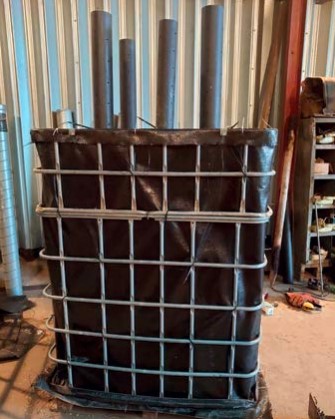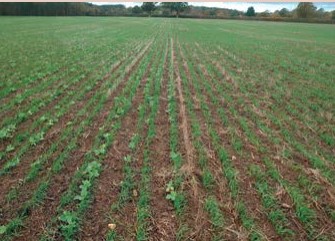
As I write at the end of February it is finally starting to feel like spring. I have even managed to go out without wellies and a coat for the first time in months. Since my last article in September, we have had rain, lots of it! 650mm since 24th of September. Parts of the farm have flooded 4 times since Christmas but after all that, the majority of our crops look well. A couple exceptions of late drilled wheat on heavy clay have suffered but we are in a lot better position compared to last year.
Since my last article I have built 4 Johnson-Su bioreactors with the aim of applying compost extract next autumn with our drill. To be able to check the quality of the compost extract I have bought a microscope, so far, I have looked at a tick off our pet cat and my daughter’s blood with it. My aim is to add a wide diversity of biology into our soil to improve nutrient cycling and plant health.
How well it works only time will tell! Recently I purchased a second-hand Claydon Terrablade Inter Row Hoe. Our grass weed issues are mainly in patches or at low levels. Recently the efficacy of Spring SU herbicides has slid to almost useless with the price staying the same, so any leftover weeds have been hand rogued or spot sprayed. This is very time consuming and I feel if I can get 70% of the patches with the hoe it will make hand rogueing quicker and overall cheaper. This first year with the hoe is going to be a steep learning curve.

The last 6 months has also seen the start of a robotic development project (UKRI funded) where I am a collaborator https://n2visionai.wordpress.com/ . The aim of this project to use a robotic platform, with various cameras onboard, to capture image data of a crop of winter wheat and analysis how the crop reacts to different rates of nitrogen fertiliser and correlate this to soil data. This image data will be run through deep learning analytics at Manchester Met Uni. The long term aim of this project is to develop the software and hardware to measure at a plant scale the Nitrogen status and treat the plants with fertiliser individually, if fertiliser is needed. This will be real precision farming.

Robotics and AI seem to be a hot topic in agriculture at the moment. I believe it has a key role to play in solving challenges we face in agriculture. One concern that people seem to have with this technology is that it will mean a loss of jobs in agriculture, there is little evidence of this in past technology revolutions. Jobs change and are created in different areas; this I believe will happen in agriculture. One of my major concerns for the future is finding decent skilled labour and being able to pay them a decent wage. A question I ask is why would anyone want to work on a modern arable farm?
Why would you work for a relatively low wage, working very unsociable long hours at the time of year everyone else is on holiday or going to festivals and have to handle potentially toxic chemicals? Not a great job advert! There seems to be a badge of honour in farming for people to work longer and longer hours, if you don’t you aren’t a proper farmer. Personally, I do not mind working long hours, but I also want to spend time with my friends and family. I hope to be the last generation of my family that sits on a tractor for 100 hours a week just to get crops planted. If we want to encourage new young blood into the industry, we need to have jobs and wages to attract them. I believe Robotics and AI can help with this issue.
Good luck to all with the rest of the season, let us hope the taps have not been turned off completely again like last year!!